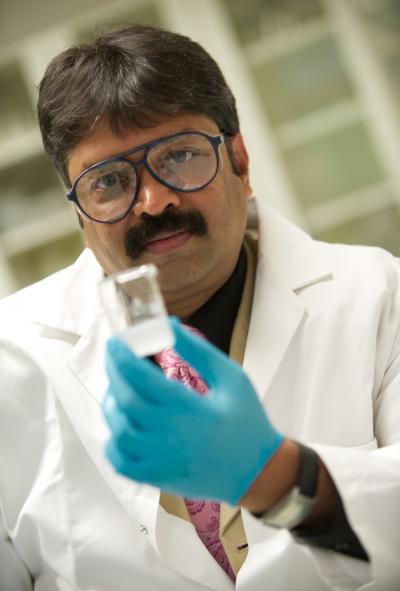Home > Press > System to deliver organ transplant drug -- without harmful side effects
 |
| This is professor Ravi Kumar of the University of Strathclyde.
Credit: University of Strathclyde |
Abstract:
A new system for delivering a drug to organ transplant patients, which could avoid the risk of harmful side effects, is being developed by scientists at the University of Strathclyde in Glasgow.
System to deliver organ transplant drug -- without harmful side effects
Glasgow, UK | Posted on January 26th, 2012The drug, cyclosporine (CsA), is widely used in transplant operations and helps prevent the patient's body rejecting the organ but it can cause adverse drug reactions, of which the most serious problems are kidney and liver damage, in the doses which are currently administered in the long term.
The gap between a safe, effective dose of the treatment and a toxic dose is extremely narrow but the Strathclyde scientists have found a way of capturing CsA in very small amounts. The new system, developed in laboratory tests, enables nanoparticles of the drug to be delivered orally so that the strength of the dose can be maintained, but at a level and in a form which spares kidneys from damage.
Professor Ravi Kumar, of the Strathclyde Institute of Pharmacy and Biomedical Sciences, led the research. He said: "CsA is very useful in transplants and treating conditions such as arthritis, lupus and some forms of diabetes, but we need to address the risks it can present to the kidney and liver, apart from various other toxicities such as convulsions and high blood pressure.
"The damage it can cause can be dealt with if it's caught at an early stage but can be irreversible if it continues unchecked. Furthermore, existing formulations of cyclosporine contain castor oil-based vehicle which is used owing to the drug's poor solubility in water but which can be toxic.
"By entrapping CsA in nanoparticles, we aimed to match the maximum concentration of the most potent formulation of the drug in market. In tests, we were able to strike a balance between strength, efficacy and safety and were able to make a marked increase in the drug's bioavailability- the level of the drug which becomes active in the system.
"We were also able to reduce the toxic effects on the kidneys by slow release of the nanoparticles, which brought the drug gradually to its maximum concentration.
"As well as its use in transplants, we hope to look into the effectiveness of this system with arthritis and address what is a hugely debilitating condition for many people."
The research paper has been published in the Journal of Biomedical Nanotechnology.
Further current research is aimed at proving the therapeutic efficacy and long-term safety of cyclosporine, with a special focus on the safety of carriers- polymers used in the formulation- to fulfil regulatory requirements. The safety studies element of the research has been funded by the Cunningham Trust Scotland and will conclude early in 2013.
The research forms part of Health Technologies at Strathclyde- one of the principal themes of the University's Technology and Innovation Centre (TIC), a world-leading research and technology centre transforming the way universities, business and industry collaborate.
Through Health Technologies at Strathclyde, academics work with industry and the health sector to find technologies for earlier, more accurate disease detection and better treatments, as well as life-long disease prevention.
####
Contacts:
Paul Gallagher
44-141-548-2370
Copyright © University of Strathclyde
If you have a comment, please Contact us.Issuers of news releases, not 7th Wave, Inc. or Nanotechnology Now, are solely responsible for the accuracy of the content.
| Related News Press |
News and information
![]() Simulating magnetization in a Heisenberg quantum spin chain April 5th, 2024
Simulating magnetization in a Heisenberg quantum spin chain April 5th, 2024
![]() NRL charters Navy’s quantum inertial navigation path to reduce drift April 5th, 2024
NRL charters Navy’s quantum inertial navigation path to reduce drift April 5th, 2024
![]() Discovery points path to flash-like memory for storing qubits: Rice find could hasten development of nonvolatile quantum memory April 5th, 2024
Discovery points path to flash-like memory for storing qubits: Rice find could hasten development of nonvolatile quantum memory April 5th, 2024
Nanomedicine
![]() New micromaterial releases nanoparticles that selectively destroy cancer cells April 5th, 2024
New micromaterial releases nanoparticles that selectively destroy cancer cells April 5th, 2024
![]() Good as gold - improving infectious disease testing with gold nanoparticles April 5th, 2024
Good as gold - improving infectious disease testing with gold nanoparticles April 5th, 2024
![]() Researchers develop artificial building blocks of life March 8th, 2024
Researchers develop artificial building blocks of life March 8th, 2024
Discoveries
![]() Chemical reactions can scramble quantum information as well as black holes April 5th, 2024
Chemical reactions can scramble quantum information as well as black holes April 5th, 2024
![]() New micromaterial releases nanoparticles that selectively destroy cancer cells April 5th, 2024
New micromaterial releases nanoparticles that selectively destroy cancer cells April 5th, 2024
![]() Utilizing palladium for addressing contact issues of buried oxide thin film transistors April 5th, 2024
Utilizing palladium for addressing contact issues of buried oxide thin film transistors April 5th, 2024
Announcements
![]() NRL charters Navy’s quantum inertial navigation path to reduce drift April 5th, 2024
NRL charters Navy’s quantum inertial navigation path to reduce drift April 5th, 2024
![]() Discovery points path to flash-like memory for storing qubits: Rice find could hasten development of nonvolatile quantum memory April 5th, 2024
Discovery points path to flash-like memory for storing qubits: Rice find could hasten development of nonvolatile quantum memory April 5th, 2024
|
|
||
|
|
||
| The latest news from around the world, FREE | ||
|
|
||
|
|
||
| Premium Products | ||
|
|
||
|
Only the news you want to read!
Learn More |
||
|
|
||
|
Full-service, expert consulting
Learn More |
||
|
|
||








